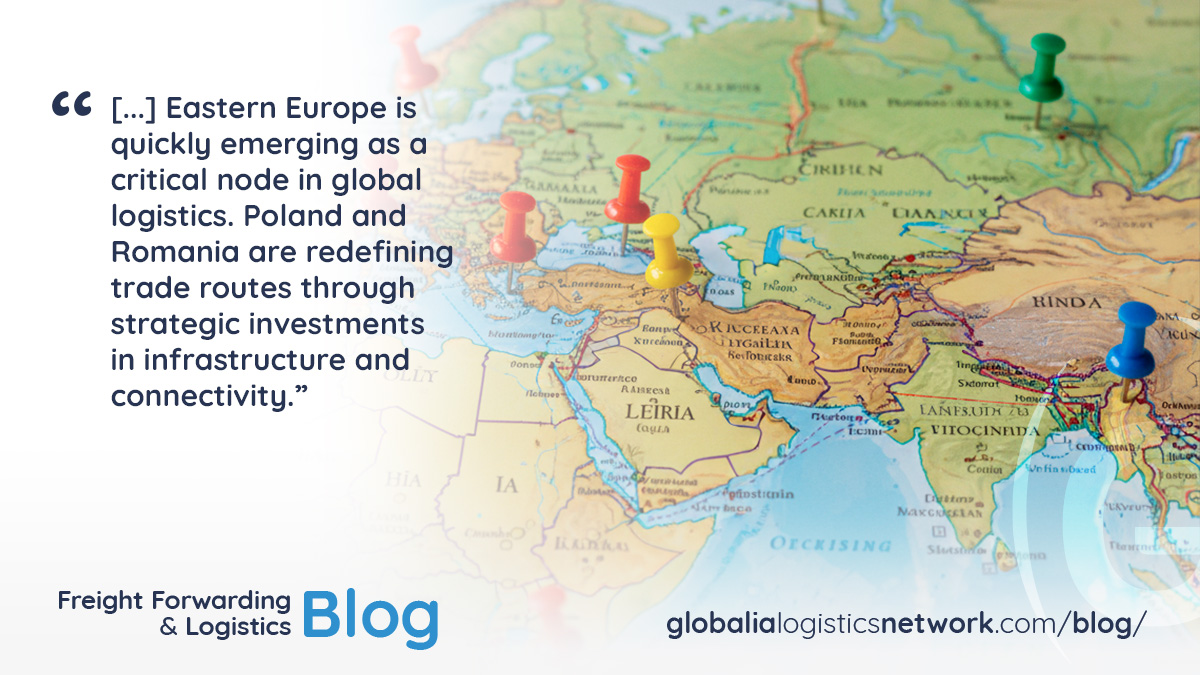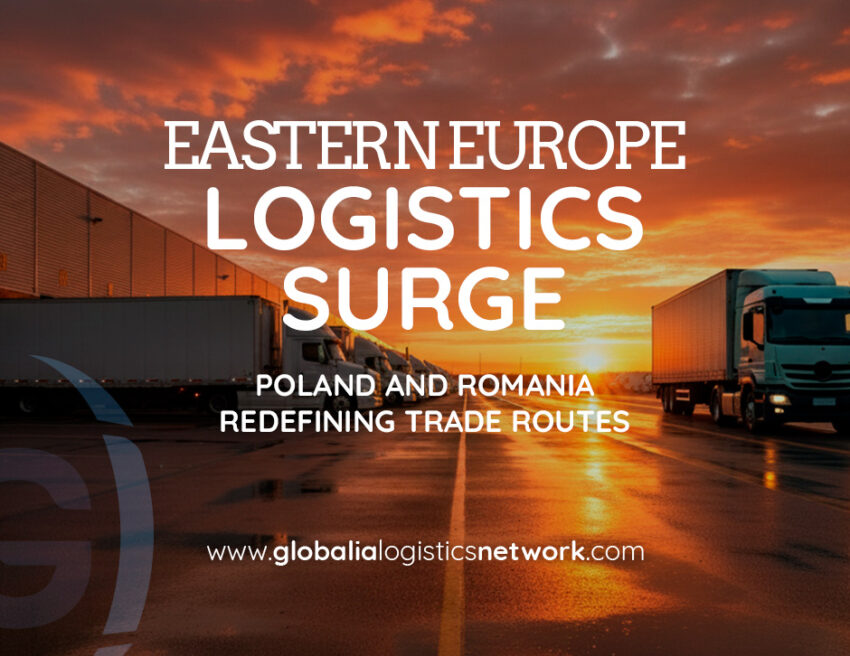Eastern Europe is quickly emerging as a critical node in global logistics. Countries like Poland and Romania are investing heavily in infrastructure, modernizing their ports, rail networks, and roadways, and creating new trade corridors that are reshaping the way goods move across the continent. For freight forwarders, understanding this surge is essential to capturing new opportunities, building reliable networks, and staying competitive in a market that is rapidly evolving.
Why Eastern Europe Logistics Is Gaining Momentum
The Eastern Europe logistics sector is growing at an impressive pace. With Poland and Romania strategically located as gateways between Western Europe, Asia, and the Balkans, the region has become a hotspot for freight forwarding and supply chain activities. EU membership for both countries has driven regulatory alignment, smoother customs processes, and access to development funds for transportation and port infrastructure.
Key cities such as Warsaw, Gdańsk, Bucharest, and Constanța are leading this surge. Warsaw serves as Poland’s central logistics hub, connecting rail, road, and air freight services. Gdańsk, with its Baltic port, is becoming an essential gateway for container traffic, particularly for automotive, electronics, and e-commerce shipments. In Romania, Bucharest’s central position and Constanța’s Black Sea port make them indispensable for both European and intercontinental trade routes.

Eastern Europe’s logistics sector isn’t just about moving goods; it is an enabler of economic growth. Investment in distribution centers, warehouses, and multimodal transport solutions is expanding the region’s capacity to serve both local and international markets. For freight forwarders, this means more freight flows, diverse cargo types, and opportunities to offer value-added services like customs clearance, warehousing, and last-mile delivery.
New Trade Corridors Driving the East Europe Logistics Surge
One of the major drivers of the Eastern Europe logistics surge is the development of new trade corridors. The North-South Corridor, connecting Poland and Romania to Hungary, Serbia, and beyond, is facilitating faster land-based transit between Central and Southeastern Europe. Simultaneously, the Baltic-Adriatic Corridor is providing a more efficient route from ports in Gdańsk and Gdynia down to the Adriatic, benefiting industries like automotive and manufacturing.
Rail freight is also playing a crucial role. Investments in modern rail infrastructure are reducing transit times and offering cost-effective alternatives to road freight. Romania’s rail upgrades linking Constanța to Central Europe, for instance, are opening opportunities for bulk cargo, containerized goods, and project shipments. Forwarders who understand these corridors and can leverage them efficiently will gain a competitive edge in the emerging logistics markets of Eastern Europe.
Key Cities Shaping Logistics in Eastern Europe
The surge in Eastern Europe logistics is not just about countries — it’s about cities that act as hubs of commerce and trade.
Warsaw, Poland: As the capital and largest city, Warsaw is the nerve center of Poland’s logistics sector. It hosts numerous distribution centers and has strong road and rail connections to Germany, the Czech Republic, and Slovakia. Freight forwarders based here benefit from proximity to large consumer markets and cross-border connections.
Gdańsk, Poland: With a deep-water port on the Baltic Sea, Gdańsk is pivotal for maritime trade. The city has seen significant investment in container terminals, making it an essential gateway for imports from Asia and exports to Europe.
Bucharest, Romania: Romania’s capital city is a key hub for road and rail freight, linking the country to Central Europe and the Balkans. It’s increasingly becoming a center for warehousing and distribution services.
Constanța, Romania: Home to the largest port on the Black Sea, Constanța is crucial for maritime freight and acts as a bridge between Eastern Europe and Asia. Modernization efforts are increasing capacity for containerized and bulk cargo, enhancing Romania’s competitiveness in international trade.
Challenges and Opportunities for Freight Forwarders
Despite the growth, freight forwarders operating in Eastern Europe face several challenges. Port congestion, fluctuating customs regulations, and occasional infrastructure bottlenecks can disrupt supply chains. Currency volatility and evolving trade policies also require constant attention. However, these challenges are accompanied by significant opportunities.
Forwarders can capitalize on growing industrial zones, expanding e-commerce markets, and increasing intercontinental trade flows. Providing value-added services such as customs brokerage, cargo insurance, and project logistics can differentiate a forwarder in a competitive market. Moreover, focusing on emerging logistics hubs in cities like Warsaw, Gdańsk, Bucharest, and Constanța ensures proximity to the fastest-moving markets.
How Joining a Network Like Globalia Logistics Network Helps
Navigating the complexities of the Eastern European logistics sector is easier when you are part of a strong network. Joining Globalia Logistics Network gives forwarders access to nearly 200 trusted partners in strategic cities across East Europe, and beyond. This collaboration enables reliable capacity, local expertise, and smoother operations in unfamiliar markets.
Being part of an international logistics network allows smaller and mid-sized forwarders to compete with multinational companies. Shared resources, technology support, and best practices make it possible to provide end-to-end logistics services, from warehousing and customs clearance to multimodal transport solutions. Additionally, network membership opens doors to joint marketing opportunities, industry insights, and face-to-face networking events that build credibility and trust among clients and partners.
Join us today before your city is taken!
The Importance of Logistics in Eastern Europe
The logistics industry in Eastern Europe is the backbone of economic growth. Efficient freight and supply chain solutions enable industries to move raw materials, components, and finished goods quickly, supporting manufacturing, retail, and export sectors. With continued investment in infrastructure, urban development, and digitalization, the region is poised to become a major player in global logistics.
The scope of this sector is vast. From maritime ports and rail corridors to warehousing, customs solutions, and air cargo hubs, every part of the logistics ecosystem in Eastern Europe is expanding. Forwarders who position themselves in the right cities and leverage networks can access new revenue streams and participate in shaping the region’s trade future.
Future Outlook for 2026
Looking ahead to 2026, Eastern European logistics is expected to experience further growth. Trade volumes will increase along key corridors, new industrial zones will emerge, and technological adoption in supply chain management will accelerate. Cities like Warsaw, Gdańsk, Bucharest, and Constanța will remain central, serving as gateways for global commerce and innovation.
Forwarders who stay proactive, adapt to market trends, and build partnerships will be best positioned to thrive. Utilizing networks like Globalia not only provides operational support but also ensures that smaller players can maintain a competitive edge against multinational freight companies.
Conclusion
The Eastern Europe logistics surge is creating exciting opportunities for freight forwarders. Poland and Romania, with their strategic locations, modernizing infrastructure, and growing trade corridors, are redefining how goods move across Europe and beyond. By focusing on key cities, understanding trade routes, and joining a network like Globalia Logistics Network, forwarders can expand their reach, enhance reliability, and compete effectively in this dynamic market. In 2026, Eastern Europe will continue to be a logistics frontier. Forwarders who act now, build strong partnerships, and leverage the support of an international network will not only survive but thrive in one of the most promising regions for global trade.


